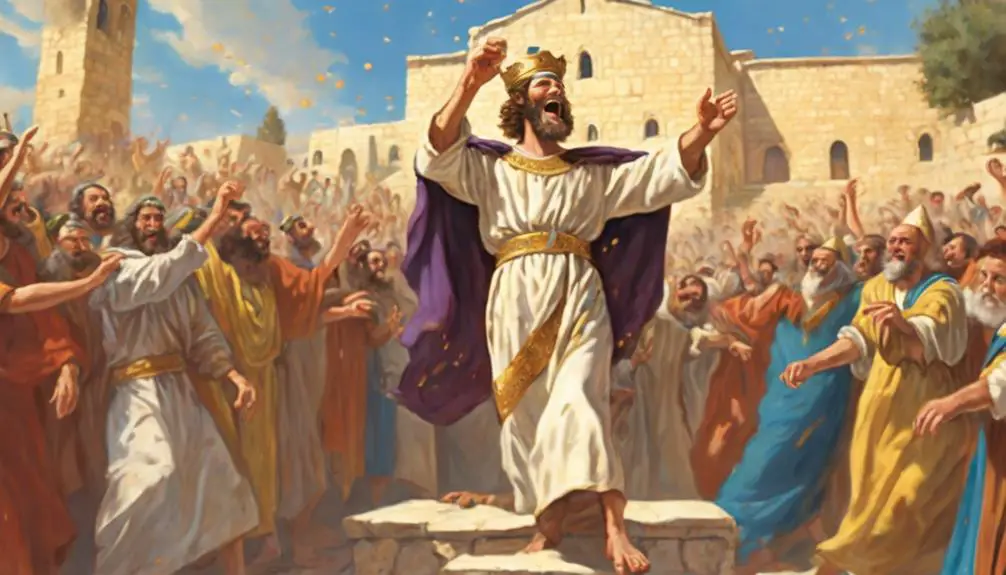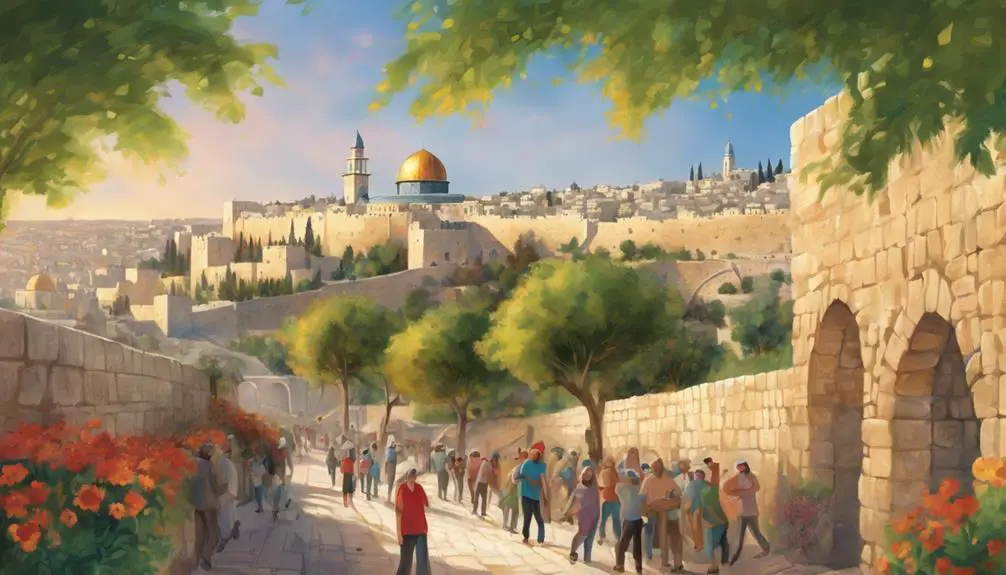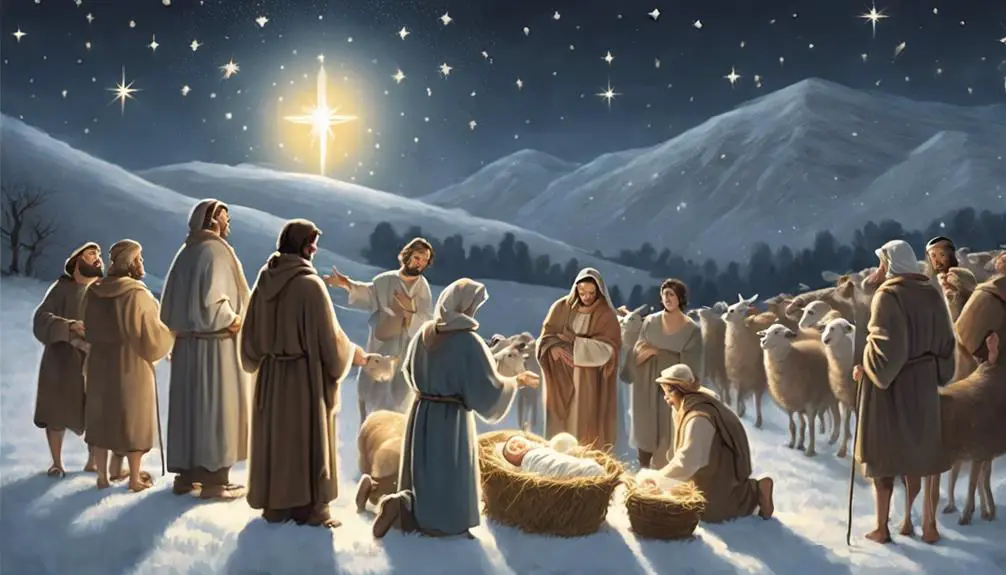Gain insights into the Bible's joyous tales, from King David's dance to the Prodigal Son's return, and rediscover the timeless essence of happiness.

Stories About Joy in the Bible
Isn't it fascinating how you stumbled upon this discussion just as you were seeking a spark of joy in your life?
The Bible, with its rich tapestry of narratives, offers some of the most profound stories about joy that resonate across centuries. From the spontaneous dance of King David, celebrating the Ark's return, to the parable of the Prodigal Son welcomed back into his father's arms, these stories aren't just ancient texts. They're a testament to the enduring power of joy in the human spirit.
As we explore these narratives together, you'll find that each story not only illuminates a different facet of joy but also invites you into a deeper understanding of its significance. Curious about how these ancient tales can impact your modern life? Let's find out together.
Key Takeaways
- Joy in the Bible is often linked to creation, expressing God's delight in creating and inviting humans to share in this divine joy.
- Biblical stories emphasize communal celebration and spiritual joy, with acts of worship and dance enhancing the collective experience of God's goodness.
- Reconciliation and forgiveness lead to profound joy, surpassing personal grievances for collective harmony, as illustrated in The Prodigal Son's return.
- Experiences of divine engagement, such as the shepherds' nighttime revelation, highlight accessible joy and the transformation it brings to individuals and communities.
Joy in Creation

In examining the concept of joy within the biblical narrative, it's evident that the act of creation itself is imbued with profound joy, as depicted in various passages of scripture. The first chapters of Genesis, often referred to as Genesis praise, offer a vivid portrayal of the world's creation, underscoring a theme of joy and satisfaction. Each act of creation concludes with the affirmation that 'God saw that it was good,' a phrase that echoes the Creator's delight in His work. This expression of satisfaction serves not only as an approval of the physical beauty and order of the created world but also signifies a deeper, intrinsic joy in the act of creation itself.
Furthermore, the Book of Job, particularly in Job's wonder, delves into a discourse on the wonders of the universe, which God presents as evidence of His power and majesty. Job 38-41, where God addresses Job out of the whirlwind, is a poetic exposition of creation's marvels, from the foundations of the earth to the behemoth and leviathan. This section doesn't merely aim to humble Job but also to instill in him a sense of wonder and joy in the complexity and beauty of creation that reflects the Creator's joy.
These passages highlight a fundamental truth within the biblical narrative: joy isn't an afterthought but a central aspect of creation. The act of creating engenders joy, not merely in the observable outcomes but in the process itself. This joy, deeply embedded in the fabric of the universe, invites humanity to partake in the divine delight that permeates creation, encouraging a posture of praise and wonder.
David's Dance of Joy

One of the most emblematic expressions of joy in the Bible is found in the account of David's dance before the Lord, a moment that epitomizes the profound spiritual elation and communal celebration inherent in biblical narratives of joy. This event, more than a mere historical footnote, offers deep insights into the nature of David's worship and the broader concept of spiritual celebration within the faith community.
- *David's Uninhibited Expression*: Unlike the often reserved or formal worship practices, David's dance symbolizes an unrestrained, passionate expression of gratitude and joy towards God. His act of dancing with all his might, wearing a linen ephod, underscores a level of humility and vulnerability in his worship.
- *Communal Aspect of Worship*: David's dance wasn't a solitary act but a centerpiece of a larger communal celebration. This highlights the collective nature of spiritual joy, where individual expressions of worship contribute to and enhance the communal experience of divine connection.
- *Spiritual Celebration as a Testimony*: Through his public display of worship, David not only expressed his own joy but also testified to the goodness and glory of God before the people of Israel. His act of dancing before the Lord served as a powerful witness, encouraging others to recognize and celebrate God's presence and blessings in their lives.
David's dance of joy stands as a timeless example of the depth and dynamism of spiritual celebration. It challenges you to embrace your expressions of joy and worship with authenticity and boldness, recognizing them as integral parts of your spiritual journey and communal life.
The Prodigal Son's Return

Shifting focus from David's communal celebration of worship, we now examine the personal journey of restoration and joy in the parable of the Prodigal Son's return. This narrative illuminates the intimate dimensions of joy, underscored by the father's forgiveness, juxtaposed with the brother's envy, offering a profound exploration of familial and divine love.
The father's forgiveness is central to understanding the parable's depiction of joy. Unlike common human reactions, the father's response to his son's return isn't conditional or hesitant but immediate and complete. This act embodies an unconditional love and acceptance, highlighting the joy in forgiveness and restoration. The father's actions—running to meet his son, embracing him, and organizing a feast—serve as metaphors for divine forgiveness and the joy that accompanies reconciliation with God. This joy isn't solitary but communal, inviting others to partake in the celebration of return and redemption.
Conversely, the brother's envy introduces a complex layer to the narrative's exploration of joy. His inability to rejoice in his brother's return reveals a nuanced understanding of human emotions and relationships. The brother's envy serves as a foil to the father's joy, illustrating that joy's fullness often requires overcoming personal prejudices and embracing a more inclusive perspective. Through this contrast, the parable invites reflection on the nature of joy as an experience that transcends personal grievances, aiming for a more collective, harmonious existence.
Joyful Rebuilding of Jerusalem

The narrative of Jerusalem's rebuilding, as chronicled in the Bible, offers a compelling study of joy rooted in collective achievement and spiritual renewal. This period, marked by Nehemiah's leadership, exemplifies how concerted community effort can overcome substantial adversity. Through an analytical lens, let's delve into the intricacies of this joyous occasion.
Nehemiah's leadership was pivotal. He didn't merely direct the physical reconstruction of Jerusalem's walls; he rekindled a sense of purpose and unity among the people. His ability to motivate, coupled with strategic acumen, catalyzed the project despite external threats and internal dissent. Nehemiah's role underscores the importance of visionary leadership in achieving communal goals.
- *Community Effort*: The rebuilding of Jerusalem wasn't the work of a single individual but a collective endeavor. Every family, irrespective of their prior occupation, contributed to the construction. This shared responsibility fostered a deep sense of belonging and mutual respect among the inhabitants.
- *Spiritual Renewal*: The physical reconstruction paralleled a spiritual revival. The people renewed their covenant with God, signifying a return not just to physical, but also to moral and spiritual fortitude.
- *Celebration of Completion*: The joyous celebration upon the completion of the walls symbolized more than just architectural achievement. It marked the restoration of the community's identity and faith in their collective power and in divine providence.
Through Nehemiah's leadership and the community's concerted effort, the narrative of Jerusalem's rebuilding encapsulates the profound joy found in overcoming adversity through unity, reflecting a timeless principle of collective resilience and spiritual reawakening.
The Shepherds' Jubilant Discovery

Drawing from the theme of joy found in communal achievements and spiritual renewal, we now turn our attention to the jubilant discovery made by the shepherds, a moment that encapsulates individual revelation within the broader narrative of divine engagement. The angelic announcement to the shepherds stands as a pivotal instance of joy's transformative power, particularly through the lens of a nighttime revelation. This event diverges from conventional expectations, where divine messages are typically reserved for figures of high status or in settings of grandeur. Instead, the choice of shepherds as recipients underscores a democratization of joy and divine favor, suggesting that spiritual enlightenment and joy are accessible to all, irrespective of societal standing.
The shepherds' response to the angelic announcement is a testament to the infectious nature of joy. Their immediate decision to seek out the newborn Christ signifies an active engagement with the divine, propelled by the joy of the revelation. This narrative segment emphasizes that true joy often compels action, a transition from passive reception to active pursuit of the divine promise.
Moreover, the nighttime setting of the revelation highlights the contrast between the ordinary and the divine, the mundane and the miraculous. It suggests that joy, especially of a spiritual nature, can pierce through the commonplace, transforming routine moments into instances of profound revelation and connection.
Paul's Letter of Joy

Amid the New Testament narratives, Paul's Letter to the Philippians stands out as a profound testament to the enduring nature of joy in the face of adversity. Penned during one of his imprisonments, this correspondence is often classified among the 'Prison epistles,' yet it radiates with a message of joy and encouragement. You're invited to explore the depth of Paul's insights into joy's source, which he shares despite his own challenging circumstances.
Paul identifies several key aspects that contribute to this joy:
- The Partnership in the Gospel: Paul emphasizes the joy derived from shared faith and mutual support among believers. This communal aspect of joy underscores the interconnectedness of the Christian community.
- The Power of Prayer and Thanksgiving: By focusing on prayer and gratitude, Paul suggests that a mindset of thankfulness towards God is crucial for experiencing joy, even in trials.
- The Pursuit of Christ-Likeness: Paul points to Jesus as the ultimate source of joy. By encouraging believers to emulate Christ's humility and servitude, he outlines a path towards a fulfilling joy that transcends earthly challenges.
Analyzing Paul's letter, it becomes evident that joy's source isn't contingent upon external circumstances but is deeply rooted in spiritual realities—faith, community, prayer, and Christ-likeness. This insight is particularly poignant, considering Paul's imprisonment, highlighting that joy can flourish even in the most dire situations. As you reflect on Paul's Letter of Joy, consider how these principles can guide you towards experiencing a deeper, more resilient joy, regardless of your current circumstances.
Frequently Asked Questions
How Do Modern Theologians Interpret the Concept of Joy in the Context of Contemporary Challenges and Suffering?
You're diving into how modern theologians tackle joy amidst today's trials. They're redefining joy as not just happiness, but as joyful resilience and suffering transcendence.
This perspective isn't about ignoring pain but finding a deeper, more steadfast joy through it. Theologians argue this joy comes from faith, community, and hope, offering a counter-narrative to despair.
Analyzing this, you see a scholarly blend of realism with an unwavering belief in enduring joy.
In What Ways Do Non-Christian Faiths Find Parallels or Differences in the Expression and Understanding of Joy Compared to the Biblical Narratives?
Imagine exploring a vast tapestry of beliefs, where Hindu festivals burst with vibrant joy, contrasting yet mirroring Biblical narratives in their communal celebration.
Delve deeper, and you'll find Sufi mysticism weaving tales of inner joy, a contemplative counterpart to biblical expressions.
These distinctions and parallels showcase a rich diversity in understanding joy across faiths, offering a comprehensive view beyond the Christian perspective, inviting a scholarly analysis of universal expressions of happiness and fulfillment.
How Has the Portrayal of Joy in the Bible Influenced Western Literature and Art Throughout the Centuries?
You've noticed how the Bible's portrayal of joy has deeply influenced Western literature and art, especially during the Renaissance. Joyful motifs, inspired by biblical narratives, are woven throughout this era's masterpieces, shaping the artistic and literary landscape.
These depictions not only reflect the era's religious beliefs but also explore the complexity of human emotions. This influence extends beyond the Renaissance, continuing to inspire works that delve into the essence of joy.
Can the Experience of Joy as Depicted in the Bible Be Reconciled With the Concept of Joy in Psychological and Neuroscience Research?
Imagine, for a moment, your brain lighting up with happiness. You'll find the concept of joy in psychological and neuroscience research focuses on neurological happiness and emotional resilience.
These scientific perspectives can indeed be reconciled with traditional views of joy. Through detailed, scholarly analysis, it's clear that both approaches highlight the multifaceted nature of joy, emphasizing its ability to emerge from various sources and its profound impact on human well-being.
What Role Does Communal Versus Individual Joy Play in the Biblical Stories, and How Does This Reflect on the Social Structures of the Time?
You're exploring how communal versus individual joy impacts narratives, focusing on festive celebrations and agricultural blessings.
This angle illuminates the social structures of ancient societies, where communal joy often reflected collective successes, like bountiful harvests, and was integral to societal cohesion.
Individual joy, while present, played a more subtle role, often tied to personal faith or achievements.
This distinction highlights the interconnectedness of community and individual well-being in these stories.
Conclusion
As you've journeyed through these biblical narratives, you've witnessed joy acting as a beacon, guiding humanity through the tumult of existence. These stories, from the ecstatic dance of David to the poignant return of the Prodigal Son, serve as a mosaic of jubilation, each piece reflecting the multifaceted nature of joy within the human and divine realms.
Analyzing these passages reveals a profound truth: joy isn't merely an emotion but a foundational element of spiritual and communal life, illuminating our path towards fulfillment and unity.



Sign up